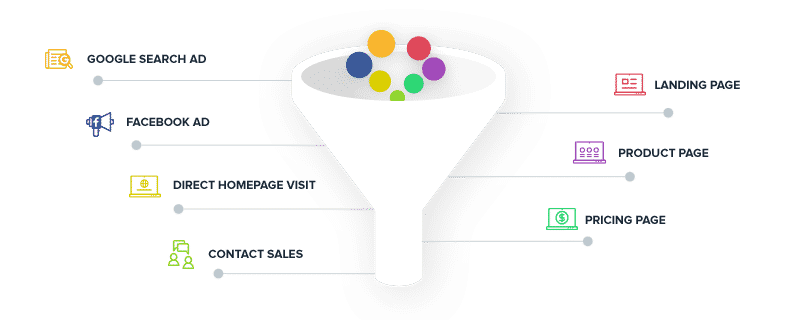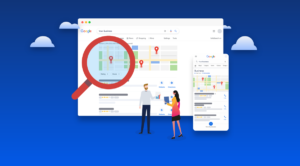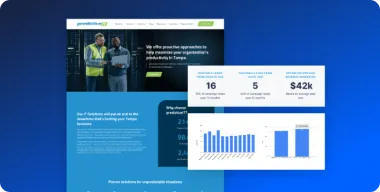How much should your small business spend on digital marketing in 2025?
As we navigate the ongoing ripples of recent Google algorithm updates, slow yet clearly evolving search and buying behaviors, and the rise of AI-powered marketing, business owners and marketers need to take a step back and make sure they’re not getting stuck in business as usual mode.
Marketing spend is often one of those items that gets targeted for savings, but what if you want to actually see results?
This blog will help you navigate the complexities of digital marketing spend, providing actionable insights tailored to your business model, industry, and location.
Digital Marketing Budget Calculator
To calculate, enter detail in the highlighted boxes
"*" indicates required fields
Digital marketing covers a wide scope of activities – some require budget (like ad spend), while others can be done by employees in-house, without always needing extra budget (like posting on social media or starting a blog).
This leaves the question, how much do you really need to spend on digital marketing to see results in 2025?
Understanding Marketing Budget Fundamentals
The Revenue-Based Approach
Considering recommendations from the U.S. Small Business Administration (SBA) and other industry benchmarks provided by research firms such as Gartner and Deloitte, most marketing experts recommend allocating between 5-15% of your total revenue to marketing, with the specific percentage depending on several key factors:
1. Growth goals
- Low growth strategy: 6-8% of revenue
- Average growth strategy: 9-12% of revenue
- High growth strategy: 13%+ of revenue
Note: Low, Average, and High growth strategies vary based on a company’s business model. For example, SaaS businesses with lower operational costs can typically afford more aggressive growth strategies with average marketing spend in the 15-25% of revenue range.
2. Industry Variations: Typical digital marketing spend varies significantly across industries
| Industry | Typical Marketing Budget (% of Revenue) |
|---|---|
| Professional Services | 6-10% |
| Healthcare & Wellness | 7-11% |
| Home Services (Plumbing, HVAC) | 8-12% |
| Restaurants & Food Services | 10-15% |
| Retail Local Businesses | 5-9% |
| SaaS (Software as a Service) | 15-25% |
While industry-level benchmarks can be helpful, we recommend finding market segment-level data to get even more relevant information. Take a look at the following data for these three Professional Services market segments that behave quite differently due to the varied nature of their work:
| Industry | Typical Marketing Budget (% of Revenue) |
|---|---|
| IT Services/Managed Service Providers (MSPs) | 8-13% |
| Law Firms | 5-8% |
| Accounting Firms (CPAs) | 4-7% |
Breaking Down Marketing Expenditure
To create a holistic marketing budget consider the following three critical categories of marketing spend:
- Marketing Campaign Spend (50-60% of Total Marketing Budget): This category encompasses direct costs associated with reaching and engaging potential customers:
- Digital advertising budget to spend on keywords or targeted audiences (for example: Google Ads, remarketing, social media ads)
- Vendor budget to spend on content creation or campaign management costs (for example agencies or freelancers you rely on to create advertising banners, manage ad or email campaigns on your behalf, do video editing)
- Event marketing
- Sponsorships
- Print and traditional advertising
- In-House Marketing Staff Costs (25-35% of Total Marketing Budget): Covers the human resources required to develop and execute marketing strategies:
- US Salary ranges for marketing professionals (will vary depending on location and seniority, and actual scope of work)
- Marketing Director: $70,000 – $120,000
- Marketing Manager: $50,000 – $80,000
- Marketing Coordinator: $35,000 – $50,000
- Content Creator/Copywriter: $45,000 – $75,000
- Benefits and overhead
- Training and professional development
- Recruitment costs
- Performance bonuses and incentives
- US Salary ranges for marketing professionals (will vary depending on location and seniority, and actual scope of work)
Pro Tip: For small and growing businesses without a dedicated marketing team or leader, a popular option is to hire a Fractional CMO as their first or second hire in order to help them not only with putting together a holistic marketing strategy and budget.
- Marketing Systems and Operational Costs (10-20% of Total Marketing Budget): Investments in tools, technologies, and infrastructure that enable effective marketing – this is commonly referred to as your Marketing Technology (MarTech) Stack:
- Customer Relationship Management (CRM) systems
- Marketing automation platforms
- Analytics and tracking tools
- Social media management software
- SEO and keyword research tools
- Video and podcast recording and editing apps
Location-Based Budget Considerations
The physical or even virtual address of a business is another key factor that will dictate how much it has to spend on certain digital marketing channels such as SEO and targeted local advertising.
Consider the following breakdown of digital marketing spend by US metro areas split into three main tiers:
Top Metro Areas (New York, Los Angeles, Chicago)
- Higher competition
- Increased digital advertising costs
Secondary Metropolitan Areas (Hartford, Birmingham, Rochester)
- Moderate competition
- More cost-effective digital channels
Suburban and Rural Areas (Cambridge, Oak Park, East Point, Beverly Hills)
- Lower competition
- Some locations may have too little volume for paid advertising to be worth it
Pro tips:
- Don’t just write off advertising channels simply due to high competition – a higher volume paired with a well-optimized campaign + high services fees can still deliver positive ROI
- If search volumes are too low because of the location or niche services or both, then certain online channels may just not be viable
Sample Budget Breakdown for a Small Local Service Business
Let’s take a look at what the sample budget may look like for an established professional services firms with a couple of in-house marketers:
Total Annual Revenue: $5,000,000
Marketing Budget Allocation: 6%
Yearly Marketing Budget: $300,000
Given the above parameters, here’s how the marketing budget can be broken down into the main three marketing spend categories:
| Category | Percentage | Amount |
|---|---|---|
| Marketing Campaign Spend (including budget and vendors) |
55% | $165,000 |
| In-House Marketing Staff | 30% | $90,000 |
| Marketing Systems | 15% | $45,000 |
Note: Percentages can vary based on business size, industry, and growth stage.
Why it’s important to keep marketing and allocating budget
First of all, let’s touch on the marketing budget and why it’s important to still have one. In tough times, many companies retrench marketing in an effort to make savings. Marketing may be seen as a luxury that should only be used during flusher periods, but does it make sense to cut back in uncertain times?
There are a few examples that show taking the opposite approach can pay off. One that is widely cited is the example of two competing cereal companies – Post and Kellogg in the early 1930s. These two great rivals had held similar market share and were strong competitors.
When the depression hit, Post pulled back its marketing budget in an effort to slim its outgoings and ride out the tough economic period. Kellogg however, took the opposite view. They pushed ahead with marketing, even doubling its budget and investing heavily in radio advertising. During this period, the brand released its new Rice Krispies product.
The move worked for Kellogg – by 1933, while the economy tanked, its profits had risen by almost 30 percent and it had cemented itself as the dominant player in the cereal market.
It seems that Kellogg took a much bigger risk by spending money during that difficult period, but it makes sense when you think about it. Which company was everyone now hearing from? Who was more likely to be on their minds if they were thinking of buying cereal?
On the other hand, pulling back the marketing budget should be looked at as risky, too. Most companies have worked hard to get to the position they’re in now – if you go off the radar for a period, people start to forget. You just might find you have to work extra-hard to claw back a position in the market when you do decide to spend on marketing again.
In our view, marketing remains essential. Sure, you might need to cut back some budget depending on the current situation of your business, but it doesn’t make sense to cut all marketing. You might find you’re also cutting off your supply of customers.
Where should your marketing budget go?
Ultimately, the marketing budget should go toward activities that help you to reach your goals. What is it that you want to achieve this year? Revenue growth? Growth of your email list? Brand recognition? Different types of digital marketing activities can help with those goals.
For example, let’s say you want to outrank competitors for certain SEO keyword phrases. Your ultimate goal is to rank near the top of search results for the term/s because this will naturally get you more search traffic to your website. This means you need to devote at least some marketing budget to SEO. You might look at something like Link Building for SEO to help boost your site authority, or Google Ads to ensure that your ad is placed near the top when people search for the keyword phrase that is relevant to your products or services.
Competitor analysis should always play a role in marketing budgetary decisions. If you have a competitor outranking you for some relevant local keywords, you’ll want to boost your paid search advertising in the short run, until you can outrank them organically in the long run.
Are you unsure how to do a digital marketing competitor analysis? We put together a list of the best free and paid SEO tools that can help you collect this data.
Here are a few other suggestions to help you prioritize and focus on where marketing spend should go:
- Clearly define your target demographic and find where they are online. Those places are where the marketing budget should go. (For example, it wouldn’t make sense to target Snapchat or TikTok if most of your customers are outside of the demographics that predominantly use them. Sites like Smart Insights regularly post data on social media use and trends).
- Identify your key challenges. Are there any barriers in the way of you achieving your marketing goals?
- Look at where competitors are spending their marketing dollars – what insights can you gain?
- What “must do” tasks do you have that require a budget? For example, if your website needs work done to optimize the user experience, that should be prioritized because there’s no sense spending to send traffic to a less-than-optimal website!
- Is your target market mostly local? Then local advertising initiatives are your best bet to start with.
- What resources do you have available? This plays a role in what is feasible for your business to take on. Marketing campaigns take research and careful crafting to be successful. Do you have someone in-house who knows digital marketing? Can you hire an agency? Do you need extra help with tasks that no one in-house has the bandwidth for?
Do bigger budgets always win?
Competing with larger businesses with bigger marketing budgets can be tough for small businesses. They seem to flood every platform and it might seem like an impossible task to compete.
Do bigger budgets always win though? The answer is no, not if you’ve done your homework, identified your target market and crafted messaging that will appeal to them. It’s more a matter of being wise about how your marketing dollars are spent, being very targeted rather than taking the “spray” approach that many big companies do.
Smaller businesses can find advantages in their size. For example, they tend to be more nimble than big businesses and able to adjust their strategy quickly. For example, you might spot specific customer pain points more quickly and adapt an offer to them.
You can find ways to be visible online with a consistent strategy. Remember too, people like to buy from small businesses! There’s a growing movement of people who prefer to “shop local,” so this could potentially be to your advantage too.
How much should you spend?
Many businesses find setting a marketing budget to be challenging. They’re just not sure what a reasonable amount means. A good place to start is with a percentage of revenue. If you can commit to investing a certain percentage back into marketing, you’ll have a figure to start with.
Getting into specifics, here’s what we’ve found:
- If you can spend 6 – 9% of revenue on marketing, this tends to be enough to maintain your current position.
- If you can spend 10-14% of revenue on marketing, this will grow your current position in the market.
- In dollar value, that obviously varies, but we’ve found a minimum of somewhere around $3,000 per month will produce sustainable growth over time if invested wisely into marketing.
Another factor to consider is that the amount you need to invest to get results can vary widely from industry to industry.
An example is if you’re targeting highly competitive keywords – you might need to spend more if those keywords are used by multiple competitors. On the other hand, a small local law firm might get good results spending $1,000 per month targeting local keyword searches.
How should you calculate return on marketing spend?
Focus on your Blended Lead Cost vs. simply on Channel Lead Cost
Trying to figure out how much you should spend on web advertising is a stressful exercise for small businesses. You need to get your name out there and compete, but it’s not like you have a slush fund to burn. Every dollar you spend has to count.
The biggest stressor is that online ads can look too costly to be a viable option. In fact, you’re likely measuring your ad performance too narrowly.
Think of how you buy services for your business. Do you click on a banner and immediately sign up? Probably not. So don’t expect that buying behavior to apply to your own ad campaigns and don’t measure your ROI on that limited basis.
When you’re searching for a vendor yourself, you’re going to check out a business multiple times before you decide to reach out and buy. The same is true with your customers, and clicking on your ad is likely one of a number of touch points in their buyer journey.
Here’s a typical example of how this works in the wild:

There’s actually a whole suite of analytics products dedicated to solving this issue of “multi-touch marketing attribution.” Don’t freak out; you don’t need to buy another tool in order to figure out how much you should spend on ads. Sure, those tools are impressive and they might make sense for you as you get more sophisticated, but there’s a more simple (and cost-effective) way to take a more holistic view of how your ads contribute to tangible results.
The metric you need to focus on is your “Blended Lead Cost”

It’s myopic to view your paid and unpaid sources of traffic separately. As you see above, the customer journey is complex. A visitor who found you through an ad could easily come back and convert after multiple visits via direct or organic.
You need to measure your results as a product of all your marketing efforts.
A focus on blended lead costs helps solve the problem of “leads from ads are too expensive but I can’t scale my free, direct, and organic leads.” By focusing on the blended picture, you’re likely to find that as ad traffic goes up, overall traffic to your site goes up. This makes sense; you’re raising overall awareness of your brand.
For example, at Pronto we had a really hard time getting leads to convert from display banners, so we decided to test a reduction in banner traffic. Lo-and-behold, pretty soon we saw a marked drop in leads from direct and organic. We hypothesized that banners were increasing the number of people seeing our brand and as a result, typing in our URL directly or company name into their search bar. So not only did we turn the display back on, we increased the budget to get more traffic and we soon found we got even more leads overall at a blended lead cost we could afford.
You’ll likely find that the blended lead cost is much more tolerable in terms of ROI, and as a result, you can actually commit more ad budget. When you are able to commit budget to ads consistently over time, you get the benefit of seeing trends and can optimize related channels. If you’re staying under your target blended lead cost, you have lots of room to test.
Final thoughts
So, what should you be spending on digital marketing in 2025?
Enough that you’re able to successfully achieve your goals.
We’ve established it’s important to keep marketing, even if the temptation is to pull back the budget during uncertain times. History tells us that if you have a good product or service that customers want, you won’t lose with strategic marketing spend.
Bigger doesn’t always win. If you’re a small business with a limited budget, you can compete with careful research and planning. If you’d like to know more about how to get digital marketing working well for you in 2025, talk to us! You can book a free consultation here.
References:
- How Marketers Are Spending Their Money in 2025 (We Asked 11,093 Marketers): https://neilpatel.com/blog/marketing-budget/ → this blog a lone could be a source of another video, blog post, or email content
- The U.S. Small Business Administration recommends, “As a general rule, small businesses with revenues less than $5 million should allocate 7-8 percent of their revenues to marketing.” This percentage is based on companies that have margins in the 10-12 percent range (after expenses).
- How Much Should a B2B SaaS Company Spend on Digital Marketing?: https://newnorth.com/b2b-saas-marketing-budget/




